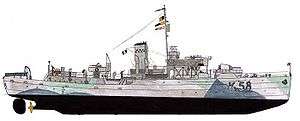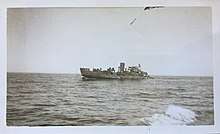French corvette Alysse
Alysse (formerly HMS Alyssum) was one of the nine Flower-class corvettes lent by the Royal Navy to the Free French Naval Forces.
 Flower-class corvette in 1942 paint | |
| History | |
|---|---|
| Ordered: | 12 December 1939 |
| Laid down: | 24 June 1940 |
| Launched: | 3 March 1941 |
| Commissioned: | 17 June 1941 |
| Identification: | Pennant number: K100 |
| Fate: | torpedoed and sunk on 9 February 1942 in the North Atlantic, in position 46º00'N, 44º00'W by the German submarine U-654 while escorting convoy ON-60[1] |
| General characteristics | |
| Class and type: | Flower-class corvette |
| Tonnage: | 900 |
| Displacement: | 950 tonnes |
| Length: | 62.7 metres (206 ft) |
| Beam: | 10.9 metres (36 ft) |
| Draught: | 2.7 metres (8 ft 10 in) |
| Propulsion: |
|
| Speed: | 16 knots (30 km/h; 18 mph) |
| Range: |
|
| Complement: | 70 |
| Sensors and processing systems: | Type 271 surface radar |
| Armament: |
|
Construction
Alysse was built by George Brown & Co.
War Service
Originally built as HMS Alyssum by the British Royal Navy, she was loaned to the Free French Navy upon completion on 17 June 1941.
In all, Alysse escorted 9 convoys:
| Year | Month | Name of convoy | |
|---|---|---|---|
| 1941 | July | convoy England-United States | |
| 1941 | August | SC-40 | |
| 1941 | September | SC-44 | |
| 1941 | September | ON-19 | |
| 1941 | October | SC-50 | |
| 1941 | November | ||
| 1941 | December | ||
| 1942 | January | SC-62 | |
| 1942 | January | ON-60 | |
Shortly after midnight on 9 February 1942 while escorting convoy ON-60, Alysse was torpedoed by the German submarine U-654.[3]. The torpedo struck Alysse on the port side in the forward part of the ship causing her to settle by the bow. The surviving crew were rescued by HMCS Hepatica and HMCS Moose Jaw; 36 crew members were lost. Hepatica then attempted to tow Alysse but after 30 minutes the tow parted. A further attempt was made to tow her to port later that day but after 18 hours Alysse foundered and sank at 6°34N/44°10W. [4]

References
- "FFL Alysse (K 100) of the Free French Navy - Free French Corvette of the Flower class - Allied Warships of WWII - uboat.net". www.uboat.net. Retrieved 22 March 2018.
- Alysse (J-1159) (+1942) Wreck site
- "FFL Alysse (K 100) (French Corvette) - Ships hit by German U-boats during WWII - uboat.net". www.uboat.net. Retrieved 22 March 2018.
- "HMS Alyssum (K 100) of the Royal Navy - British Corvette of the Flower class - Allied Warships of WWII - uboat.net". www.uboat.net. Retrieved 22 March 2018.
- Friedman, Norman (2008). British Destroyers and Frigates: The Second World War and After. Barnsley, UK: Seaforth Publishing. ISBN 978-1-84832-015-4.CS1 maint: ref=harv (link)